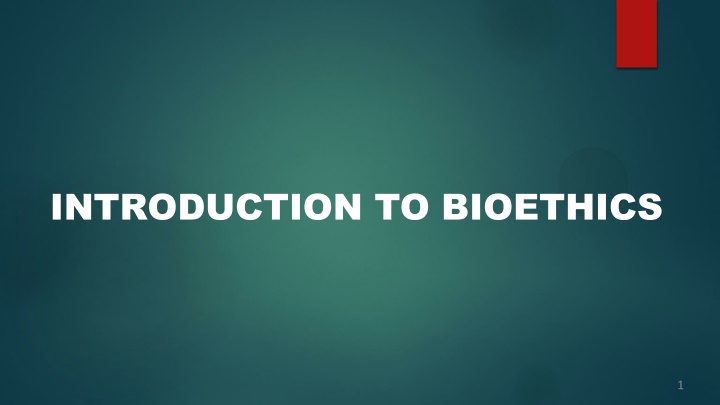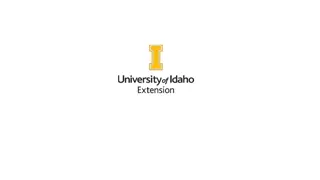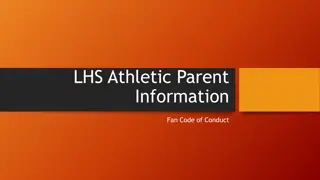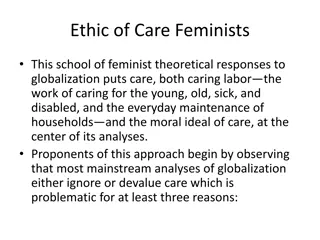
Bioethics: Concepts, Principles, and Historical Significance
Explore the essence of ethics and bioethics, delving into the guiding principles and historical milestones such as the Nuremberg Code, Declaration of Helsinki, Belmont Report, and the role of the ICMJE. Gain insights into the ethical considerations in research involving human subjects.
Download Presentation

Please find below an Image/Link to download the presentation.
The content on the website is provided AS IS for your information and personal use only. It may not be sold, licensed, or shared on other websites without obtaining consent from the author. If you encounter any issues during the download, it is possible that the publisher has removed the file from their server.
You are allowed to download the files provided on this website for personal or commercial use, subject to the condition that they are used lawfully. All files are the property of their respective owners.
The content on the website is provided AS IS for your information and personal use only. It may not be sold, licensed, or shared on other websites without obtaining consent from the author.
E N D
Presentation Transcript
ethics Ethics: a set of concepts and principles that guide us in determining what behavior helps or harms sentient creatures". The Cambridge Dictionary of Philosophy states that the word "ethics" is "commonly used interchangeably with 'morality' ... and sometimes it is used more narrowly to mean the moral principles of a particular tradition, group or individual." 3
History The Nuremberg Code 4 1947 The Nuremberg Code - the 1st international code of ethics for research on human subjects, is adopted. The Code requires that research cannot take place without the subject s consent; that research must be scientifically well-designed and socially valuable That research must minimize harm and suffering and should not involve a significant risk of death or disabling injury
History Declaration of Helsinki 5 The World Medical Association published the Declaration at Helsinki, Ethical Principles for Research Involving Human Subjects, in 1964. The Declaration is morally binding on physicians, and that obligation overrides any national or local laws or regulations, if the Declaration provides for a higher standard of protection of humans than the latter. The Helsinki Declaration has been revised numerous times, most recently in 2013 (7th revision)
History Belmont Report 6 In 1979, the National Commission for the Protection of Human Subjects in Biomedical and Behavioral Research publishes The Belmont Report: Principles of Ethical Research on Human Subjects. The Report articulates three ethical principles for research with human subjects, respects for persons, beneficence, and justice. It provides a conceptual foundation for a major revision of the U.S. federal research regulations in 1981
History - ICMJE 7 In 1997, the International Committee of Medical Journal Editors (ICMJE), representing over 400 biomedical journals, revises its authorship guidelines. The ICMJE recommends that to be an author on a scientific paper one must make a substantial contribution to research design, data collection, data analysis, or data interpretation and write the paper or critically revise and review it.
Bioethics Bioethics: a field of study concerned with the ethics and philosophical implications of certain biological and medical procedures, technologies, and treatments, such as organ transplants, genetic engineering, and care of the terminally ill 9
A classic bioethical decision One heart available who should get it? 70-year-old woman 40-year-old school principal 17-year old girl 11
A classic bioethical decision One heart available who should get it? 70-year-old woman 40-year-old school principal 17-year old girl 12
What What is is Medical Medical Ethics? Ethics? 13
Medical Medical Ethics Ethics A group of guidelines, generally written by physicians, about the physician s ideal relationship to his peers and to his patients. The basic concept of medical ethics is that the physician has a moral (and at times legal) obligation to act for the patient s good, using the most up-to-date information. The question are how to establish the good, who defines it, and what are the components thereof? 14
Reasons that Responsible for the Interest in the Health Ethics Reasons that Responsible for the Interest in the Health Ethics 15
Significant technological and scientific advances and changes in clinical medicine and research have produced totally new ethical dilemmas and exacerbated old ones. The change in philosophy from paternalism to autonomy in the physician-patient relationship. The involvement of additional caregivers (various medical specialists, a variety of health professionals, students, administrators and investigators). The involvement of society at large (through the mass communication media, courts, legislators). 16
Ethics and the law Ethics and the law 17
Ethical decisions are based on what is best for the common good and, generally, exceed what is required by law. Legal decisions are based on what is mandated by statutes or case law 18
Important Principles Important Principles Scientific and humanistic components must be combined. The subjective feelings of the patient, which are based on personal, social, cultural, and economic value systems, must be considered. 19
Thanks 20
Ethics in Research Ethics in Research In 1990, Executive Editor Dr. Marcia Angell of the New England Journal of Medicine reiterated the journal s position that only research conducted in accordance with the rights of human subjects would be published. The results of unethical research would not be published, regardless of scientific merit. 21
Differences Between Research and Practice Differences Between Research and Practice The Belmont Report distinguished between research and practice. Practice includes interventions designed to enhance the well-being of a patient through either diagnosis or treatment and that have a reasonable expectation of success. Research was defined as an activity designed to test a hypothesis, permit conclusions to be drawn, and thereby to develop or contribute to generalizable knowledge (expressed, for example, in theories, principles, and statements of relationships). 22
Ethical Issues Abortion Euthanasia suicide Determination of death Cloning Human experimentation Birth Control In vitro fertilizations Stem cell technology Homosexuality 23
Institutional Review Bodies (IRB) The IRB must 1. Identify risks of the research 2. Minimize risks as much as possible 3. Identify probable benefits 4. Evaluate the risks in relation to the benefits 5. Ensure that research subjects are provided with an accurate and fair description of the risks, discomforts, and anticipated benefits, 24
7. Ensure that research subjects are offered the opportunity to voluntarily accept or reject participation in the research, or discontinue participation, without coercion or fear of reprisal or deprivation of treatment to which the patient is otherwise entitled. 8. determine intervals of periodic review and, when necessary, determine the adequacy of mechanisms for monitoring data collection. 25
26 Main Ethical Principles Main Ethical Principles
Ethical Principles Ethical Principles 27 1. 1. Beneficence patient. Beneficence - a practitioner should act in the best interest of the 2. Non Non- -malfeasance malfeasance - "first, do no harm". 3. Autonomy treatment. Autonomy - the patient has the right to refuse or choose their 4. Justice Justice - concerns the distribution of scarce health resources, and the decision of who gets what treatment (fairness and equality). 5. Non discriminatory treatment Non discriminatory treatment.
Ethical Principles cont. Ethical Principles cont. 28 6. Dignity right to dignity. Dignity - the patient (and the person treating the patient) have the 7. Truthfulness and honesty increased in importance since the historical events of the Doctors Trial of the Nuremberg trials and Tuskegee Syphilis Study. Truthfulness and honesty - the concept of informed consent has
Conflicts Between Values Conflicts Between Values 29
For example, the principles of autonomy and beneficence clash when patients refuse lifesaving blood transfusion, and truth-telling was not emphasized to a large extent before the HIV era. 30
Beneficence Beneficence The moral obligation to do good for others, and to help them in an active way. There are limits to the requirement that one act to help others at all times. These vary with the degree of need, the ease and ability with which the help can be rendered, and the nature of the relationship between the individual needing help and the one able to provide it. 31
Autonomy Autonomy Paternalism is an approach in which the physician chooses the treatment for the patient because the physician s professional knowledge, experience and objectivity best qualify him to judge the ideal treatment for the patient. Autonomy means that only the patient knows what is best for him and only he has the right to decide. In order to do so he/ she needs to receive from the physician all the appropriate information about his condition to permit him to make an informed decision. The physician s values, and even less his professional knowledge and experience, play no role in the final decision. Traditionally, the physician s role was viewed as giving orders to nurses and to patients (e.g. order-entry, physician orders, etc.). In the atmosphere of autonomy, physicians must use a different language such as advise, recommendation, etc. 32
Autonomy cont. Autonomy cont. Respect for autonomy is the basis for informed consent and advance directives. Individuals capacity for informed decision making may come into question during resolution of conflicts between Autonomy and Beneficence. 33
Drawbacks of Autonomy Drawbacks of Autonomy The main criticism of pure autonomy is that the physician has little influence on the patient s decision, which is often based on a lack of full understanding of his condition. Such a decision may cause unnecessary and avoidable harm to the patient 34
Non Non- -malfeasance malfeasance Is defined as the obligation not to harm others and to remove and prevent potential harm. DO NO HARM!! Thus, one must not only prevent intentional harm but must also be appropriately cautious not to cause harm. 35






















